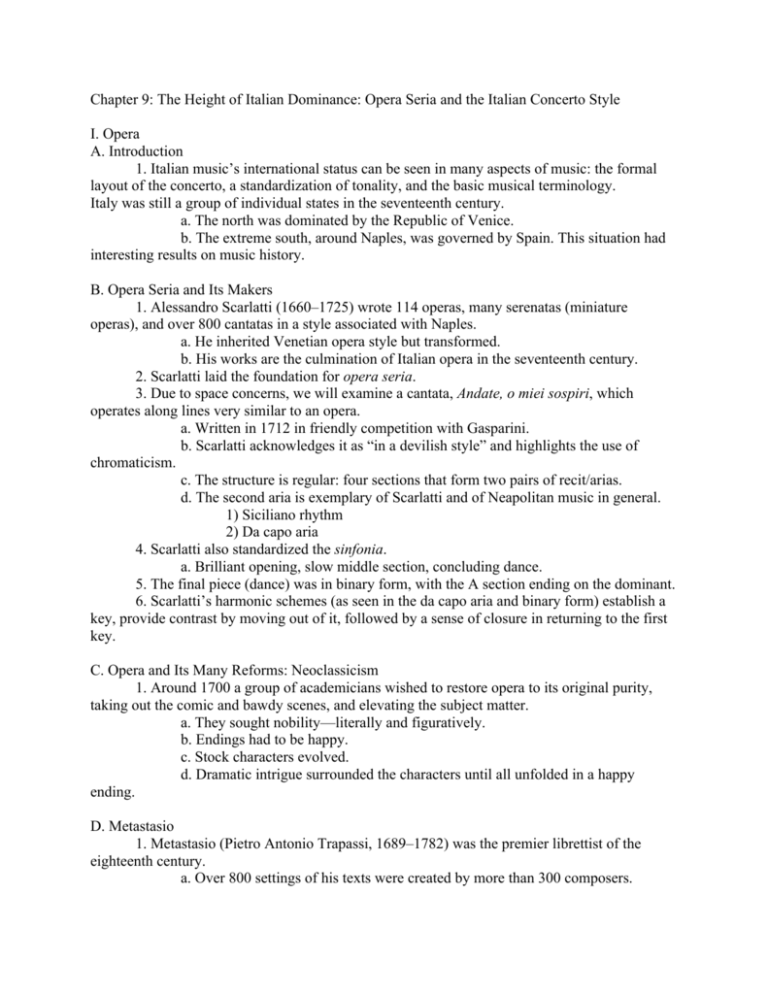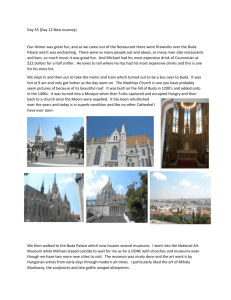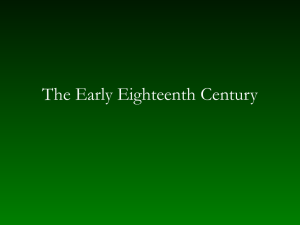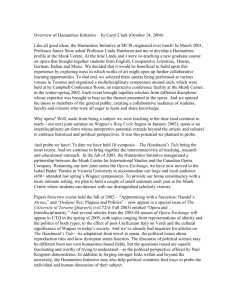Chapter 9: The Height of Italian Dominance: Opera Seria and the
advertisement

Chapter 9: The Height of Italian Dominance: Opera Seria and the Italian Concerto Style I. Opera A. Introduction 1. Italian music’s international status can be seen in many aspects of music: the formal layout of the concerto, a standardization of tonality, and the basic musical terminology. Italy was still a group of individual states in the seventeenth century. a. The north was dominated by the Republic of Venice. b. The extreme south, around Naples, was governed by Spain. This situation had interesting results on music history. B. Opera Seria and Its Makers 1. Alessandro Scarlatti (1660–1725) wrote 114 operas, many serenatas (miniature operas), and over 800 cantatas in a style associated with Naples. a. He inherited Venetian opera style but transformed. b. His works are the culmination of Italian opera in the seventeenth century. 2. Scarlatti laid the foundation for opera seria. 3. Due to space concerns, we will examine a cantata, Andate, o miei sospiri, which operates along lines very similar to an opera. a. Written in 1712 in friendly competition with Gasparini. b. Scarlatti acknowledges it as “in a devilish style” and highlights the use of chromaticism. c. The structure is regular: four sections that form two pairs of recit/arias. d. The second aria is exemplary of Scarlatti and of Neapolitan music in general. 1) Siciliano rhythm 2) Da capo aria 4. Scarlatti also standardized the sinfonia. a. Brilliant opening, slow middle section, concluding dance. 5. The final piece (dance) was in binary form, with the A section ending on the dominant. 6. Scarlatti’s harmonic schemes (as seen in the da capo aria and binary form) establish a key, provide contrast by moving out of it, followed by a sense of closure in returning to the first key. C. Opera and Its Many Reforms: Neoclassicism 1. Around 1700 a group of academicians wished to restore opera to its original purity, taking out the comic and bawdy scenes, and elevating the subject matter. a. They sought nobility—literally and figuratively. b. Endings had to be happy. c. Stock characters evolved. d. Dramatic intrigue surrounded the characters until all unfolded in a happy ending. D. Metastasio 1. Metastasio (Pietro Antonio Trapassi, 1689–1782) was the premier librettist of the eighteenth century. a. Over 800 settings of his texts were created by more than 300 composers. 2. He set the number of main roles at six, two pairs and a remainder. 3. At the top were the “primo uomo” and “prima donna,” the latter a term still in use today. a. These two received about half the arias in an opera. b. The next couple, also noble, received three or four arias each. c. Lower ranking characters came last, with no more than two arias. 4. He also regularized the types of arias: a. Aria di bravura (fast and difficult, coloratura) b. Aria d’affetto (emphasizing long-held, swelling notes) c. Aria cantabile (lyrical) 5. Metastasio saw the aria as a reflective piece, not soliloquy. 6. He directed the composer Hasse to set passages of recitative as accompanied recitative. E. Metastasio’s Musicians 1. Metastasio’s most frequently used libretto is Artaserse, a story about the Prince of Persia, ruler after his father Xerxes’ assassination. a. Almost all the leading opera composers of the eighteenth century set this text. 2. Opera seria was sung in Italian, all over Europe. a. The singers were usually Italian virtuosos. b. They interpolated much into operas, including their own favorite pieces. 3. The greatest eighteenth-century singer was Farinelli (Carlo Broschi, 1705–82), a castrato. a. He began his career in Naples, traveled to London, and ended it at the court of Philip V of Spain. b. The arias Farinelli sang gave him the opportunity to show off various aspects of his voice, including elaborate ornamentation, long phrases, etc. 1) The crucial point for such display was the cadenza. c. Not everyone admired such fireworks. F. Operatic Culture and Politics 1. In the eighteenth century, singers and librettists were considered more important to opera than the composer. a. Metastasio recognized Farinelli as a great influence on the development of opera seria. 2. This being the case, eighteenth-century values differ from our own. a. Aspects of the culture seems at odds with one another: particularly the desire for reform and purity pitted against the fantastical display of the singers. b. Audiences were comparatively rude by our standards. c. Opera seria descended from court practices, hailing nobility and royalty, absolutism. d. Star singers were the product of commercial theater; many did not read music well but improvised, seducing listeners in the process. e. Social spaces differed, too: The “home” was not a place for socializing so much as the opera box. 3. Opera seria represented a patriarchal society. a. Audiences behaved well when the king was present, as the opera was basically about him. b. This raises issues for us today because we know of the ills associated with this society. 1) How we perceive these operas has to be colored with the eighteenthcentury values. II. Concerto A. Corelli and New Tonal Practices 1. A virtuoso violinist, the composer Arcangelo Corelli (1653–1713) did not write vocal music. a. He was the first composer to achieve “great” status for his instrumental works. b. He standardized genres and practices that led to instrumental music rising in esteem throughout Europe. 2. With Corelli (and others of his time), we see the creation of harmonically controlled form. a. The new tonal system allowed composers to provide a predictable path by which the music should go, only to thwart it when the audience did not expect it. 3. Corelli’s career parallels that of Scarlatti, except the former was in Rome. 4. He led orchestras and created music for them. a. Sonata da chiesa (including the trio sonata) - for sacred venues b. Concerto grosso - back-up band for the soloists c. Sonata da camera (essentially a dance suite) - for secular venues 5. The second movement of Op. 3, #11 (sonata da chiesa) illustrates Corelli’s use of tonality. a. The emphasis on tonic/dominant statements of the main theme establishes their relationship. b. The use of sequences through the cycle of fifths builds upon these expectations. c. The drive inherent in this process yields a “dynamically unfolding formgenerating process.” d. These processes engage the mind of the listener differently from previous instrumental works; the end result is an aggressive music that does not allow for a passive experience. B. Vivaldi’s Five Hundred 1. In northern Italy, a style of instrumental writing evolved that featured an overall form of fast-slow-fast. a. The earliest of these belong to Torelli, a contemporary of Corelli. b. The main composer of such works is Antonio Vivaldi (1685–1741). 2. Composing for a girls’ orphanage, Vivaldi successfully built the music program. a. A series of Sunday concerts showcased the ensembles—and Vivaldi. b. He wrote over 500 concertos, three-fourths of which are for solo instrument and orchestra. Half of these are for violin, which was his instrument. 3. Vivaldi’s concertos follow formulas, not surprising due to the sheer number that have survived. a. The first movement generally alternates a ritornello (played by the orchestra, or ripieno) with episodes for the soloist. 1) The solo part is virtuosic and entertains the audience—structurally subordinate while dramatically dominant. 2) The ritornello supplies structure and harmonic grounding—dramatically subordinate while structurally dominant. 3) This juxtaposition may reflect a social paradigm. b. Remaining movements follow styles seen in opera. 4. The effects of Vivaldi’s concertos must have been dazzling—shocking the audience and engaging them to respond. C. Music Imitating Nature: Vivaldi’s The Four Seasons 1. Vivaldi’s earliest publication of concertos shows the flamboyant young composer at his most extravagant. These were widely copied and arranged (including by J. S. Bach). 2. In 1725 he published another volume, and the first four concertos in this have become his most famous works: The Four Seasons. a. These works were popular in France, especially “Spring.” b. The work carries a corresponding sonnet that celebrates spring. 1) Vivaldi noted where the music was to evoke the text. 2) Letter A is the ritornello; letters B–E correspond to the episodes. c. The storm, birds, brook, etc. are all pictured in the music. 1) Sometimes these are especially detailed, heightening the emotional experience for the listener. 2) The practice mimics simile arias. 3) They remind us—and reminded Vivaldi—of madrigalisms. 3. In Vivaldi’s concertos, we can find elements of old style (imitation, polyphony, madrigalisms) alongside the most up-to-date innovations (instrumental structures, tonality, new ways of playing the violin).







